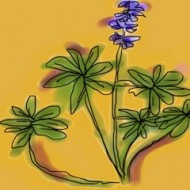The Dry Garden: Wild in Westwood
Katarina Eriksson, former manager of the herb garden at the Huntington and now manager of Rancho Santa Ana Botanic Garden's new Grow Native Nursery in Westwood. She stands on a site that last week was about to be leveled to make way for 10,000 plants. In a partnership with the federal Department of Veterans Affairs, returned servicemen and women will be working with Eriksson in the nursery, which opens this weekend. Click on the image for more information. Photo: Emily Green
For many Southern Californians, switching from a conventional landscape to a native plant garden starts on the freeways.
The best nurseries can be a long drive away. Only in recent years have some native plant outposts crept into relatively central parts of Los Angeles. The Theodore Payne Foundation for Wildflowers & Native Plants runs the most fragrant stall at the Sunday Hollywood Farmers Market, and in January Rancho …
The Dry Garden: Dig it
The fig beetles seem late this year, and maybe they are. It’s been unseasonably cool for much of the summer. Yet when these drowsy fliers properly known as Cotinis mutabilis appear, it’s a cue. It’s time to empty the contents from the bottom of your compost bins to make room for fresh additions at the top.
Why? These bugs, also called June beetles, are in search of decomposing vegetation in which to lay eggs, where their grubs will become an integral part of the composting process. If you want to enlist these most excellent helpers and prepare your compost bin for fall planting, the time to do it is now.
You will need a pitchfork, a wheel barrow, some burlap, a scoop shovel and fluent profanity.
Click here to keep reading ‘The Dry Garden’ in the Los Angeles Times. Then by all means please return to check newly compiled listings …
The Dry Garden: Pruning sage
Last spring, horticulturist Lili Singer remarked to me that one of the most touching mistakes she sees made by novice dry gardeners is timidity in pruning their sages. And so, in the summer edition of the Theodore Payne Foundation’s Poppy Print newsletter, she nudges native gardening converts to do it.
With thanks to Lili for the push, I am going to echo the prompt in this column in the hope that others may learn to work out their frustrations on their gardens in such a timely fashion.
If it seems late, it isn’t. Only the most ferociously organized gardeners dead-head sage as soon as the flowers fade in June. Watching the flush of flowers drying on the branch through July and August makes for too many sunset grace notes. As Lili notes, birds move in and glean the seeds. Yet by late August, those fluttering elegies to spring just …
The Dry Garden: Wet policy for a dry year
Source: NOAA. Click on the maps to be taken to composite graphics of precipitation trends during La Niña years.
We’ve been getting mixed messages about whether or not we need to conserve water. On one hand, we had a decent local rain year. Last week, the state legislature pulled a water bond from the November ballot that would have driven state-wide conservation. This week, the Los Angeles City Council amended the two-day lawn sprinkler ordinance to a three-day version.
Crisis over?
Not by a long shot. Local rain doesn’t fill our pipes. Of the three main sources that do, Lake Mead, the Colorado River storage reservoir serving Southern California, shrank in July to its lowest level since 1956. Last month, the State Water Resources Control Board concluded that the Sacramento-San Joaquin Delta is overdrawn by 50%. Southern California could do its part to fix that by reducing water use from …
New rules, alas not by Bill Maher
'Urban slobber' from street-side sprinkler run-off, 9.30am, Tuesday August 17, 2010 in front of the Los Angeles County Arboretum and Botanic Garden. Photo: Emily Green
The Los Angeles City Council on Wednesday approved a new lawn-watering ordinance, superseding the standing two-day-a-week sprinkler rule with a revision that allows lawn-watering on three days.
Designed to allay pressure on aging city pipes, the new rule will require Department of Water & Power customers whose street addresses end with an odd number to use lawn sprinklers on Mondays, Wednesdays and Fridays, while Los Angeles residents with even-numbered addresses should water on Tuesdays, Thursdays and Sundays.
To keep reading the update in the Los Angeles Times, click here. For what Chance of Rain thinks about this, click here, and here. Then please rip out your lawn.…
« go back — keep looking »

